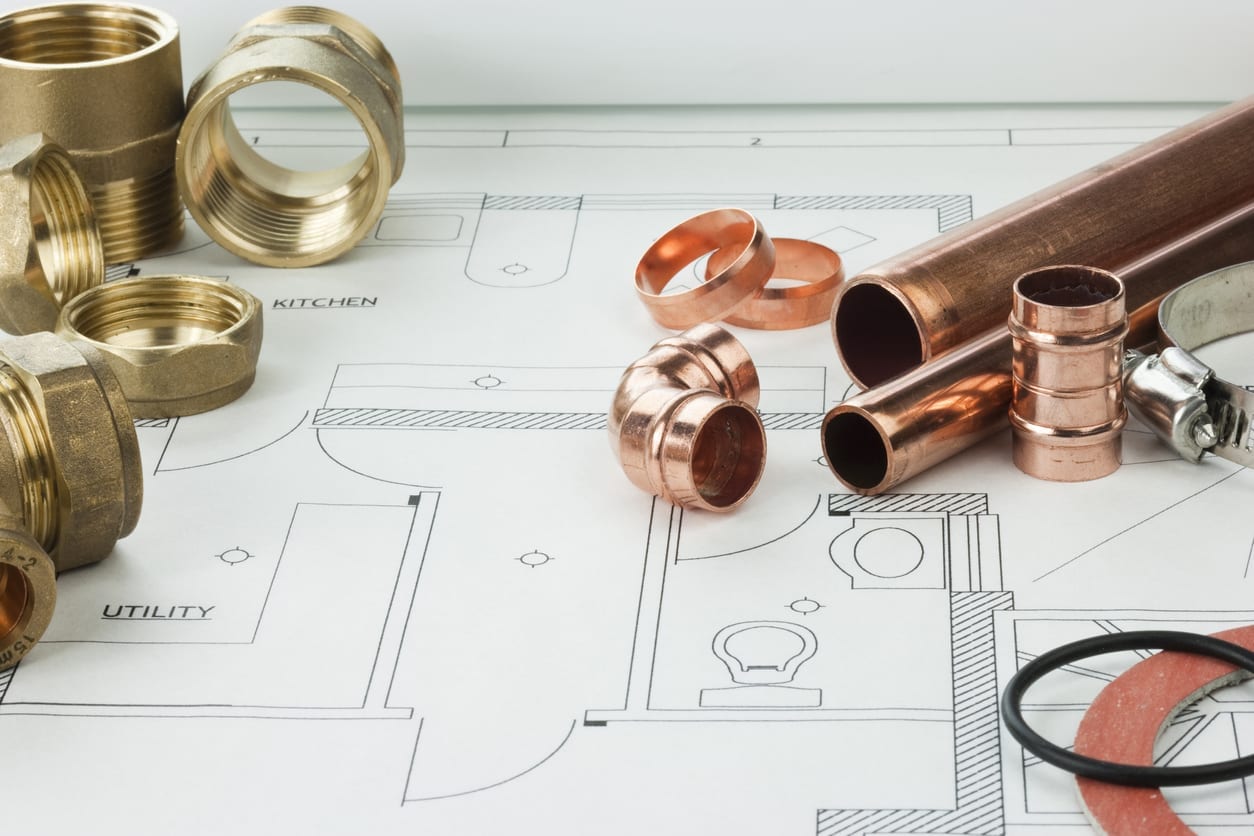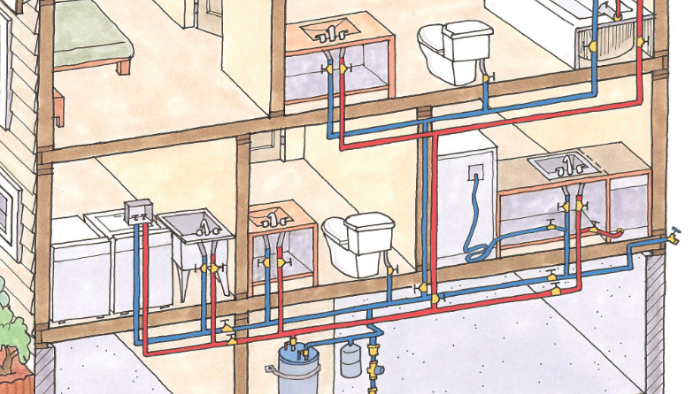A Closer Look at The Anatomy of Your House's Plumbing System
A Closer Look at The Anatomy of Your House's Plumbing System
Blog Article
What're your ideas about Exploring Your Homes Plumbing Anatomy?

Comprehending how your home's pipes system functions is vital for every home owner. From providing clean water for alcohol consumption, cooking, and bathing to securely eliminating wastewater, a well-kept pipes system is important for your family's wellness and comfort. In this thorough overview, we'll check out the detailed network that makes up your home's plumbing and deal suggestions on maintenance, upgrades, and managing typical concerns.
Intro
Your home's plumbing system is more than simply a network of pipes; it's an intricate system that ensures you have accessibility to clean water and effective wastewater removal. Understanding its parts and how they collaborate can help you avoid pricey repair work and make certain whatever runs smoothly.
Fundamental Components of a Pipes System
Pipes and Tubes
At the heart of your plumbing system are the pipelines and tubes that bring water throughout your home. These can be constructed from different materials such as copper, PVC, or PEX, each with its benefits in terms of longevity and cost-effectiveness.
Fixtures: Sinks, Toilets, Showers, and so on.
Fixtures like sinks, bathrooms, showers, and bath tubs are where water is utilized in your home. Comprehending just how these fixtures connect to the plumbing system aids in detecting problems and planning upgrades.
Valves and Shut-off Factors
Shutoffs regulate the circulation of water in your pipes system. Shut-off valves are important during emergency situations or when you require to make repair work, allowing you to separate parts of the system without interrupting water circulation to the whole home.
Water System System
Key Water Line
The primary water line links your home to the community supply of water or a private well. It's where water enters your home and is dispersed to different fixtures.
Water Meter and Pressure Regulator
The water meter steps your water usage, while a pressure regulator ensures that water flows at a safe stress throughout your home's plumbing system, avoiding damages to pipelines and fixtures.
Cold Water vs. Hot Water Lines
Comprehending the difference between cold water lines, which provide water directly from the primary, and hot water lines, which bring warmed water from the water heater, assists in fixing and planning for upgrades.
Drainage System
Drain Piping and Traps
Drain pipelines bring wastewater away from sinks, showers, and commodes to the sewer or sewage-disposal tank. Traps stop drain gases from entering your home and likewise trap debris that could create obstructions.
Air flow Pipelines
Air flow pipelines enable air into the drainage system, preventing suction that can slow drainage and cause traps to empty. Appropriate air flow is crucial for preserving the honesty of your pipes system.
Relevance of Correct Drainage
Ensuring proper drainage avoids backups and water damage. Frequently cleansing drains pipes and keeping catches can stop costly repair services and expand the life of your plumbing system.
Water Heating Unit
Types of Water Heaters
Hot water heater can be tankless or typical tank-style. Tankless heating systems warm water as needed, while storage tanks keep heated water for immediate use.
How Water Heaters Connect to the Pipes System
Recognizing just how hot water heater link to both the cold water supply and warm water distribution lines helps in identifying problems like inadequate warm water or leakages.
Upkeep Tips for Water Heaters
Regularly flushing your water heater to remove sediment, checking the temperature settings, and examining for leaks can prolong its life expectancy and improve power performance.
Typical Pipes Problems
Leakages and Their Reasons
Leaks can happen because of aging pipes, loose fittings, or high water pressure. Addressing leaks promptly prevents water damage and mold and mildew development.
Obstructions and Clogs
Blockages in drains and toilets are frequently brought on by flushing non-flushable items or a buildup of grease and hair. Utilizing drainpipe displays and bearing in mind what decreases your drains can avoid obstructions.
Indicators of Pipes Issues to Watch For
Low tide stress, sluggish drains, foul odors, or unusually high water costs are indicators of prospective plumbing problems that need to be resolved immediately.
Plumbing Maintenance Tips
Normal Assessments and Checks
Arrange annual pipes assessments to catch issues early. Seek indications of leaks, deterioration, or mineral build-up in faucets and showerheads.
DIY Upkeep Tasks
Easy tasks like cleansing faucet aerators, checking for commode leaks using color tablets, or shielding subjected pipes in cool environments can prevent significant plumbing issues.
When to Call a Specialist Plumbing
Know when a pipes problem calls for expert proficiency. Trying complicated repair services without proper expertise can lead to even more damage and greater repair expenses.
Upgrading Your Pipes System
Factors for Updating
Updating to water-efficient fixtures or changing old pipelines can improve water high quality, reduce water bills, and boost the value of your home.
Modern Pipes Technologies and Their Benefits
Check out modern technologies like smart leak detectors, water-saving bathrooms, and energy-efficient hot water heater that can conserve money and decrease ecological influence.
Expense Factors To Consider and ROI
Compute the upfront expenses versus long-lasting financial savings when thinking about pipes upgrades. Numerous upgrades spend for themselves through minimized energy costs and less fixings.
Ecological Impact and Conservation
Water-Saving Components and Appliances
Setting up low-flow taps, showerheads, and toilets can significantly decrease water usage without giving up performance.
Tips for Minimizing Water Use
Simple practices like taking care of leaks quickly, taking much shorter showers, and running complete lots of laundry and meals can save water and reduced your energy costs.
Eco-Friendly Plumbing Options
Think about lasting pipes products like bamboo for flooring, which is durable and environmentally friendly, or recycled glass for countertops.
Emergency Readiness
Actions to Take Throughout a Plumbing Emergency
Know where your shut-off valves are located and exactly how to switch off the water in case of a ruptured pipe or major leak.
Value of Having Emergency Situation Calls Convenient
Maintain call information for local plumbings or emergency services readily available for quick reaction during a plumbing dilemma.
DIY Emergency Fixes (When Applicable).
Temporary fixes like using duct tape to patch a leaking pipe or placing a bucket under a dripping tap can decrease damages till a specialist plumbing professional gets here.
Verdict.
Comprehending the composition of your home's plumbing system equips you to maintain it effectively, conserving time and money on fixings. By adhering to normal upkeep routines and staying informed concerning modern-day pipes innovations, you can ensure your plumbing system runs successfully for several years to find.
Understanding Your Home Plumbing System: A Comprehensive Guide
Plumbing System: The Lifeline of Your Home
At its core, the plumbing system is designed to perform two primary functions: bring fresh water into your home and remove wastewater. The system is a network of pipes, fixtures, and other components that transport water and sewage. Residential plumbing systems include potable water supply lines, drain-waste-vent (DWV) systems, and various plumbing fixtures that make water use in daily tasks possible.
Key Components:
Water Supply: This part of your plumbing system brings municipal water into your home, passing through the main water supply line. It s responsible for supplying all water needs, from drinking to bathing.
Drainage System: It carries waste and water away from your home to the sewer or septic system. This system includes all the piping within your home that leads to external sewage or septic systems.
Vent System: An essential yet often overlooked component, the vent system allows sewer gases to escape and lets air into the drainpipes, ensuring water and waste move correctly through the system.
Fixture: More Than Just Taps and Toilets
Plumbing fixtures are the most interactive parts of the plumbing system, including faucets, showers, toilets, and sinks. Each fixture is connected to the plumbing system and plays a role in either the delivery of freshwater or the disposal of waste and wastewater.
Types of Fixtures:
Faucets and Sinks: Used for washing hands, dishes, and other daily water needs.
Toilets: Dispose of human waste through the sewage system.
Bathtubs and Showers: Provide bathing facilities, requiring both hot and cold water supply.
Water Supply: The Source of Life
The water supply system is a critical component, ensuring that potable water is available throughout your home for various uses, including drinking, cooking, and cleaning. This system consists of pipes that distribute water to different parts of the house, controlled by valves to regulate the water flow.
Types of Plumbing: Materials and Methods
Various types of plumbing systems and materials are used in residential settings, each with its advantages and applications. From copper and PVC pipes for water supply to cast iron and ABS for drainage, the choice of materials can impact the longevity and efficiency of your plumbing system.
https://intownplumbingtx.com/articles/home-plumbing-system-guide/

Understanding Your Home Plumbing System: A Comprehensive Guide
Plumbing System: The Lifeline of Your Home
At its core, the plumbing system is designed to perform two primary functions: bring fresh water into your home and remove wastewater. The system is a network of pipes, fixtures, and other components that transport water and sewage. Residential plumbing systems include potable water supply lines, drain-waste-vent (DWV) systems, and various plumbing fixtures that make water use in daily tasks possible.
Key Components:
Water Supply: This part of your plumbing system brings municipal water into your home, passing through the main water supply line. It s responsible for supplying all water needs, from drinking to bathing.
Drainage System: It carries waste and water away from your home to the sewer or septic system. This system includes all the piping within your home that leads to external sewage or septic systems.
Vent System: An essential yet often overlooked component, the vent system allows sewer gases to escape and lets air into the drainpipes, ensuring water and waste move correctly through the system.
Fixture: More Than Just Taps and Toilets
Plumbing fixtures are the most interactive parts of the plumbing system, including faucets, showers, toilets, and sinks. Each fixture is connected to the plumbing system and plays a role in either the delivery of freshwater or the disposal of waste and wastewater.
Types of Fixtures:
Water Supply: The Source of Life
The water supply system is a critical component, ensuring that potable water is available throughout your home for various uses, including drinking, cooking, and cleaning. This system consists of pipes that distribute water to different parts of the house, controlled by valves to regulate the water flow.
Types of Plumbing: Materials and Methods
Various types of plumbing systems and materials are used in residential settings, each with its advantages and applications. From copper and PVC pipes for water supply to cast iron and ABS for drainage, the choice of materials can impact the longevity and efficiency of your plumbing system.
https://intownplumbingtx.com/articles/home-plumbing-system-guide/
As a fervent person who reads about Understanding Your Home's Plumbing Anatomy, I imagined sharing that excerpt was worthwhile. Please set aside a second to promote this write-up if you liked it. Many thanks for going through it.
Call Today Report this page